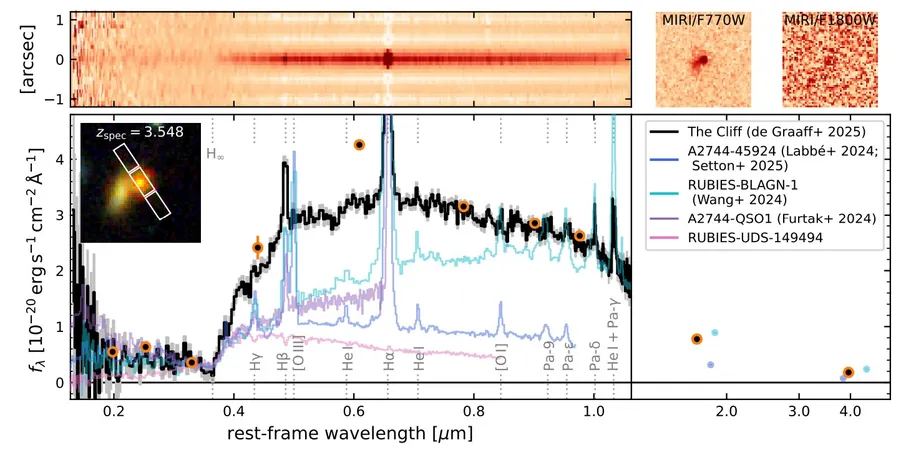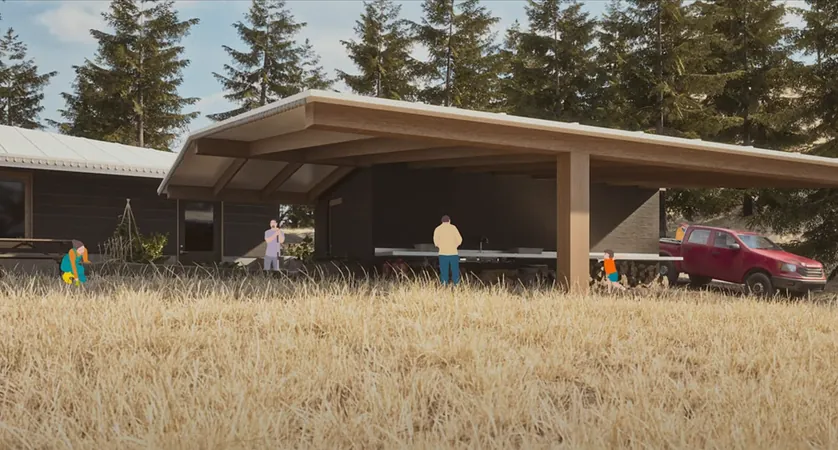
The Cliff: The Key to Unlocking the Mystery of the Red Dots in Space
2025-09-20
Author: Jacob
A Revolutionary Discovery in the Cosmos
Astronomers are buzzing with excitement over a new class of supermassive black holes—dubbed "The Cliff"—which might finally unravel the mystery behind the perplexing small red dots found in some images captured by the James Webb Space Telescope (JWST).
Unraveling the Enigma of Little Red Dots
The James Webb Space Telescope, with its powerful infrared capabilities, has provided a glimpse into the farthest reaches of the universe, revealing galaxies often tinged with a red hue. However, these tiny red dots have left scientists scratching their heads. Initially thought to be young galaxies, follow-up studies revealed they were mysteriously massive, leading to the intriguing discovery of "The Cliff."
The Journey Begins
In the summer of 2022, shortly after JWST began its scientific mission, astronomers stumbled upon these unusually compact red celestial objects. Unlike anything seen before, these dots emerge distinctly in JWST's sensitive imagery, representing an entirely new class of astronomical phenomena that even eluded the Hubble Space Telescope.
A Clash of Theories
Initial theories regarding the tiny red dots were contentious—some scientists suggested they were galaxies teeming with stars masked by thick layers of dust, while others posited they were obscured active galactic nuclei, where immense black holes feed on falling matter. Both interpretations struggle to explain the dots’ unique spectrum, leaving astronomers in a quandary.
The Anti-Cliffhanger
However, with a breakthrough on the horizon, the RUBIES program, led by Anna de Graaff and her international team, successfully obtained unprecedented spectroscopic data from 4,500 distant galaxies. Among these findings was "The Cliff," an object that has captivated researchers due to its extreme distance—its light taking 11.9 billion years to reach us.
A New Kind of Cosmic Object
Named for its distinct spectral features, The Cliff appears unlike any proposed model for the little red dots. De Graaff and her colleagues are now entertaining a radical new idea: a "black hole star"—a supermassive black hole surrounded by a dense cloud of hydrogen gas. This model provides a coherent and compelling explanation for The Cliff's peculiar characteristics.
Implications for Galaxy Formation
If these black hole stars prove to be correct, they could significantly alter our understanding of how galaxies formed in the universe's infancy. Theoretical studies suggest that these structures could facilitate astonishingly rapid black hole growth in early galaxies, a possibility that could reshape current models of galaxy evolution.
The Road Ahead
While the findings around The Cliff are groundbreaking, they represent just the beginning of a new journey. Essential questions regarding its formation and the longevity of its gas envelope remain unanswered. Upcoming follow-up observations with JWST aim to further dissect the mysteries of The Cliff and potentially change our astrophysical framework forever.
Conclusion: A New Chapter in Astronomy
The discovery of The Cliff symbolizes a thrilling frontier in astronomy. As more data surfaces and theories are tested, we may be on the brink of some of the most profound revelations about our universe yet.









 Brasil (PT)
Brasil (PT)
 Canada (EN)
Canada (EN)
 Chile (ES)
Chile (ES)
 Česko (CS)
Česko (CS)
 대한민국 (KO)
대한민국 (KO)
 España (ES)
España (ES)
 France (FR)
France (FR)
 Hong Kong (EN)
Hong Kong (EN)
 Italia (IT)
Italia (IT)
 日本 (JA)
日本 (JA)
 Magyarország (HU)
Magyarország (HU)
 Norge (NO)
Norge (NO)
 Polska (PL)
Polska (PL)
 Schweiz (DE)
Schweiz (DE)
 Singapore (EN)
Singapore (EN)
 Sverige (SV)
Sverige (SV)
 Suomi (FI)
Suomi (FI)
 Türkiye (TR)
Türkiye (TR)
 الإمارات العربية المتحدة (AR)
الإمارات العربية المتحدة (AR)